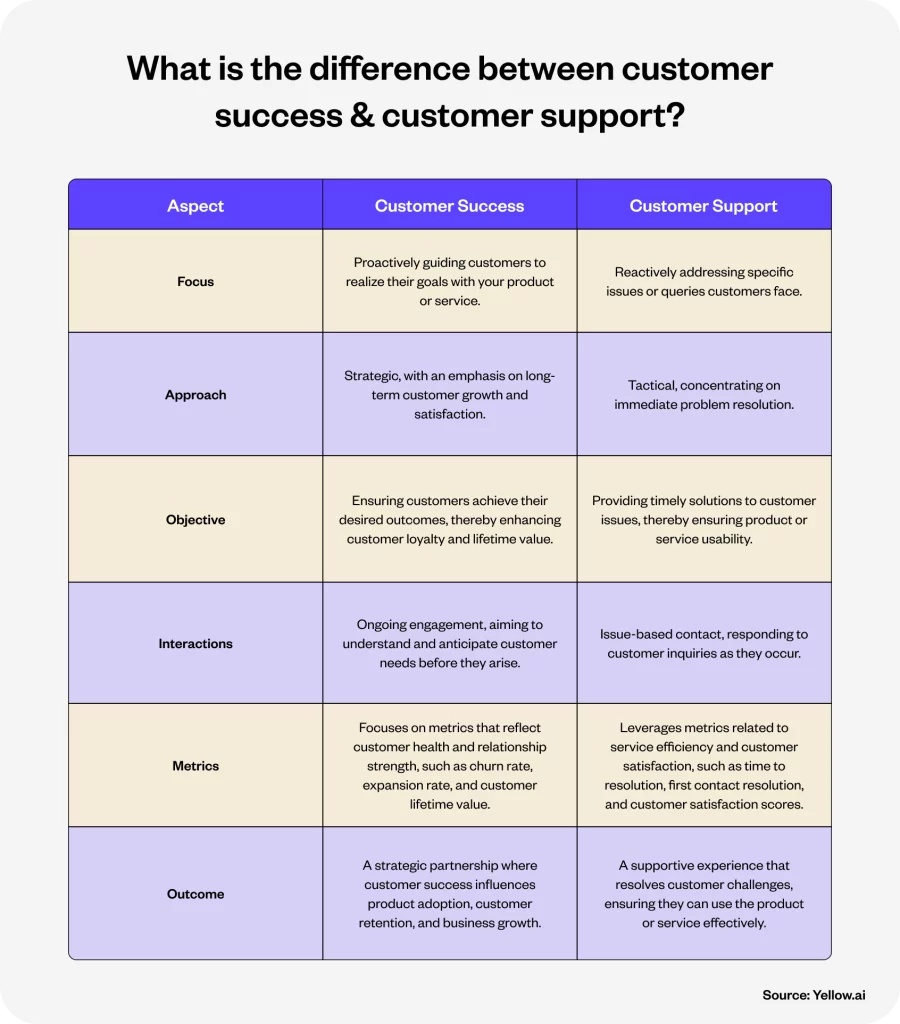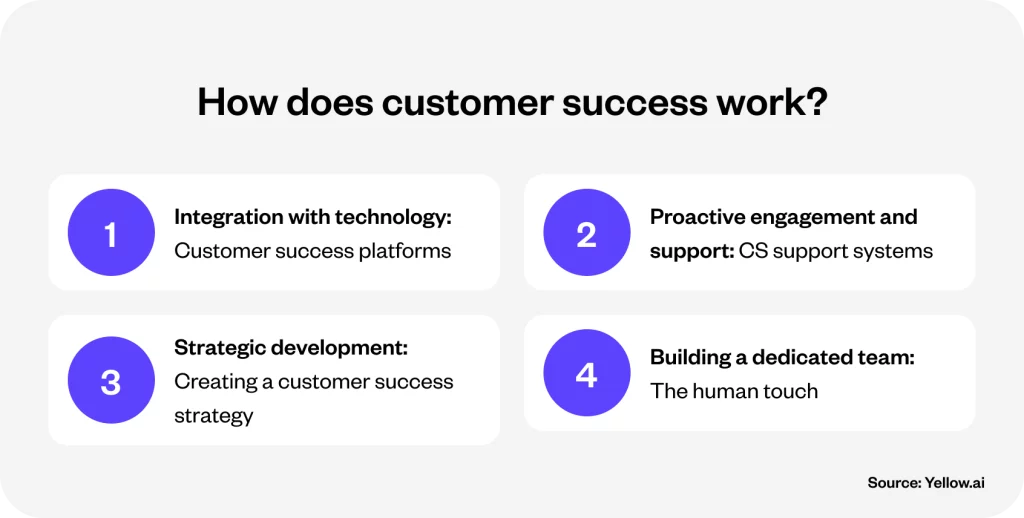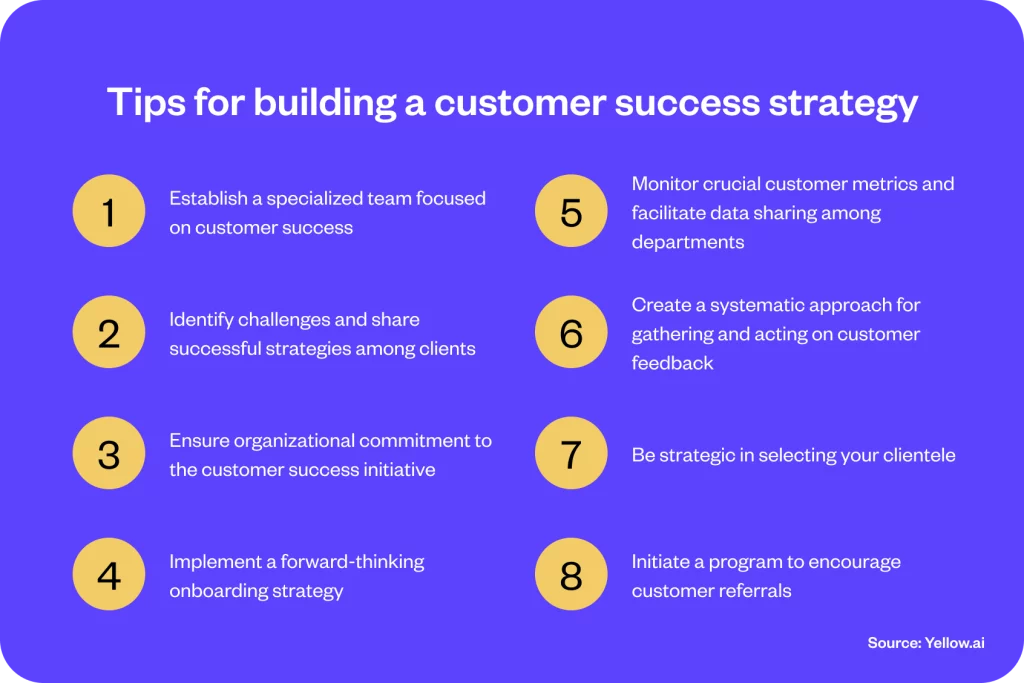Executive summary
In today’s market, customer success emerges as a pivotal force driving business growth and customer loyalty. This comprehensive guide delves into the essence of customer success, exploring its importance, differentiation from customer support, and effective implementation strategies. With a focus on establishing long-term customer relationships, we explore actionable insights and the role of innovative tools in ensuring customer success.
Imagine navigating the business world where your victory is intimately tied to the triumphs of your customers. In the contemporary landscape, this is not just an ideal but a necessity for thriving amidst fierce competition. Customer success stands at the heart of this paradigm, ensuring that businesses guarantee their customers achieve their desired outcomes. It’s a strategy that transforms passive consumers into active advocates, reinforcing the foundation for sustainable growth.
In the era of AI and cutting-edge technologies, the role of customer success has evolved beyond traditional boundaries. These tools enhance the ability to track and predict customer needs. Additionally, it offers personalized strategies to ensure every customer’s journey succeeds. This guide is your compass to navigating the nuanced realm of customer success, providing you with the knowledge and tools to ensure that your business and your customers grow together.
Related must-reads:
- Customer service software: How to select the best one
- Omnichannel customer service – [Strategy + Examples]
- Customer service automation: Benefits and examples
What is customer success?
In the ever-evolving landscape of business, customer success emerges as a key strategy and pivotal ethos driving the modern market. At its core, customer success is a dedicated endeavor to ensure customers achieve their desired outcomes while using your product or service. It goes beyond traditional customer service by actively guiding customers through their journey. That helps establish a deep relationship that transcends mere transactions.
The essence of customer success lies in its proactive nature. Unlike reactive support systems that wait for issues to arise, customer success teams anticipate customer needs and work tirelessly to address them before they become obstacles. These teams leverage data analytics and customer insights to tailor their approach. It ensures that each customer interaction solves problems and also enhances the overall experience with the product or service.
The impact of customer success on businesses is profound. By focusing on the long-term success of their customers, companies unlock pathways to increased retention, loyalty, and revenue. This approach cultivates a fertile ground for customer advocacy, where satisfied clients become the most vocal champions of your brand. In a world where customer expectations are higher than ever, embracing customer success is essential for any business looking to thrive in the customer-centric era.
Why does customer success matter?
Behind every succesful business lies a deep commitment to customer success. It’s a strategic approach that goes beyond mere customer satisfaction, aiming to ensure that customers achieve their desired outcomes through the use of your products or services. This emphasis on customer achievement and value realization underscores the vital role of customer success in today’s business landscape. Let’s explore the reasons why customer success is paramount for businesses.

1. Building long-term relationships
Customer success is instrumental in building strong and enduring relationships between businesses and their customers. By actively supporting customers in realizing their objectives, companies demonstrate a genuine investment in their success. Besides building trust, it also cements customer loyalty. That transforms ordinary users into fervent advocates of your brand. Such relationships are the foundation upon which customer retention and brand loyalty are built.
2. Gathering and applying insights
A proactive customer success strategy offers businesses several insights directly from their user base. Through continuous interaction and feedback, companies learn about customer needs, preferences, and pain points. This invaluable information can be harnessed across various departments, from product development to marketing. It enables businesses to tailor their offerings more precisely and enhance the overall customer experience. By listening to and acting on customer feedback, businesses can adapt and evolve in alignment with their customers’ evolving needs.
3. Enhancing business outcomes
At its core, customer success is a growth driver. Besides retaining existing revenue by reducing churn, it also opens avenues for additional revenue streams through upsells and cross-sells. Customers who find success and value in a product are more likely to expand their usage and explore other offerings. Moreover, satisfied customers are the best advocates. That is because they recommend your products or services to others, which can significantly reduce the cost of acquiring new customers. In essence, a well-executed customer success strategy directly contributes to the financial health and expansion of a business.
What is the difference between customer success & customer support?
Distinguishing between customer success and customer support is crucial for tailoring your approach to build lasting customer satisfaction and loyalty. These roles, though closely aligned in their commitment to customer excellence, diverge significantly in their methodologies, objectives, and outcomes. Let’s decode these concepts to illuminate how they uniquely contribute to a business’s success.
Customer success vs. customer support: A comparative overview

| Aspect | Customer Success | Customer Support |
| Focus | Proactively guiding customers to realize their goals with your product or service. | Reactively addressing specific issues or queries customers face. |
| Approach | Strategic, with an emphasis on long-term customer growth and satisfaction. | Tactical, concentrating on immediate problem resolution. |
| Objective | Ensuring customers achieve their desired outcomes, thereby enhancing customer loyalty and lifetime value. | Providing timely solutions to customer issues, thereby ensuring product or service usability. |
| Interactions | Ongoing engagement, aiming to understand and anticipate customer needs before they arise. | Issue-based contact, responding to customer inquiries as they occur. |
| Metrics | Focuses on metrics that reflect customer health and relationship strength, such as churn rate, expansion rate, and customer lifetime value. | Leverages metrics related to service efficiency and customer satisfaction, such as time to resolution, first contact resolution, and customer satisfaction scores. |
| Outcome | A strategic partnership where customer success influences product adoption, customer retention, and business growth. | A supportive experience that resolves customer challenges, ensuring they can use the product or service effectively. |
How does customer success work?
Customer success is not a standalone concept but a multifaceted operation that involves detailed planning, execution, and constant evaluation. Here’s how it works:

1. Integration with technology: Customer success platforms
These sophisticated tools are the backbone of any effective customer success strategy. By integrating with your CRM and product data, CSPs provide real-time insights into customer behavior, usage patterns, and satisfaction levels. They enable customer success teams to proactively identify accounts that may need additional support, those ready for upselling, or those at risk of churning.
Roles involved:
- Data analysts: To interpret customer data and trends.
- Technical support specialists: To address specific product usage queries.
2. Proactive engagement and support: CS support systems
Beyond software, the human element—your customer success managers (CSMs) —play a pivotal role in turning data into actionable strategies. They personalize the customer journey, offering solutions, educational resources, and regular check-ins to ensure clients are leveraging your product to its full potential.
Roles involved:
- Customer success managers: To build and maintain customer relationships.
- Educational content creators: To develop resources that help customers maximize product value.
3. Strategic development: Creating a customer success strategy
This strategy outlines how you will engage with customers at every stage of their journey. It answers critical questions about your current customer experience, how customer success can enhance it, preferred communication channels, and engagement frequencies to ensure a seamless and supportive customer lifecycle.
Roles involved:
- Strategy planners: To map out the customer success journey.
- Communication specialists: To tailor messages across preferred channels.
4. Building a dedicated team: The human touch
The success of customer success lies in the hands of its people. A dedicated team equipped with insights from CSPs is essential for transforming your company’s approach from reactive to proactive. It ensures customers stay with you and grow with your product.
Roles involved:
- Onboarding specialists: To ensure a smooth start to the customer journey.
- Professional services: To offer expert advice and tailored solutions.
Tips for building a customer success strategy
Embarking on the journey of sculpting an exceptional customer success strategy is about cultivating a thriving ecosystem where your clients grow and succeed alongside your business. Here’s how you can build a comprehensive strategy that resonates with your customers and also becomes a core part of your organizational DNA.

1. Establish a specialized team focused on customer success
The cornerstone of any effective customer success strategy is a team solely dedicated to ensuring your customers achieve their desired outcomes. This team is more than just a support crew. They are the architects of your customers’ journeys, equipped to anticipate needs and proactively offer solutions.
Path to implementation:
- Diversify your team with individuals who bring various skills to the table, from technical expertise to soft skills like empathy and communication.
- Emphasize continuous learning to keep the team updated on product innovations and customer engagement strategies.
- Build a culture of collaboration where successes and learnings are shared to elevate the customer experience collectively.
A well-curated team transforms customer interactions from transactional exchanges to meaningful conversations. It sets the stage for lasting relationships and fostering brand loyalty. Imagine a coffee shop where baristas know your order before you say it. That’s the level of personalized service a specialized customer success team aims to provide, making each customer feel like the most important person in the room.
2. Identify challenges and share successful strategies among clients
Understanding your customers’ challenges is only half the battle; sharing solutions that have worked for others in similar situations is how you win the war. It’s about creating a knowledge-sharing ecosystem that benefits all your clients.
Path to implementation:
- Conduct thorough analyses of customer feedback to pinpoint recurring challenges.
- Create a repository of case studies that detail how certain challenges were overcome.
- Organize regular knowledge-sharing sessions where customers can learn from each other.
This approach solves individual customer issues and also creates a sense of community among your clients. It reinforces the value of your service or product in addressing their needs. Think of it as a neighborhood watch program where everyone benefits from shared vigilance. Similarly, customers can protect and enhance their interests through collective wisdom and shared strategies.
3. Ensure organizational commitment to the customer success initiative
True customer success is a company-wide ethos, not just the mandate of one team. It’s about embedding a customer-centric perspective into every department, from product development to marketing.
Path to implementation:
- Secure executive buy-in by demonstrating the tangible benefits of a customer success strategy on the company’s bottom line.
- Integrate customer success metrics into broader business objectives to align efforts across departments.
- Champion a unified customer-centric culture that permeates every aspect of the organization.
When the entire organization rallies around the principle of customer success, it leads to innovations and improvements that significantly enhance the overall customer experience. Consider a symphony orchestra where every musician’s performance is vital to the overall experience. Similarly, every department’s contribution is crucial to the symphony of customer success.
4. Implement a forward-thinking onboarding strategy
A customer’s journey begins the moment they decide to use your product or service. A proactive and comprehensive onboarding process sets the tone for this journey and also significantly reduces the time to value. That enhances customer satisfaction from the outset.
Path to implementation:
- Tailor onboarding experiences to match the specific needs and knowledge level of each customer.
- Leverage multimedia resources like video tutorials, webinars, and step-by-step guides for a diverse learning experience.
- Offer personalized onboarding sessions for high-value clients to ensure they are fully equipped to get the most out of your service.
Effective onboarding accelerates the customer’s ability to navigate your product or service. It leads to quicker adoption, higher satisfaction, and reduced churn. For instance, imagine being handed the keys to a new car by a personal instructor who will guide you through all its features. Similarly, a solid onboarding process smoothly introduces customers to the experience, ensuring they know how to navigate the journey ahead with confidence.
5. Monitor crucial customer metrics and facilitate data sharing among departments
Data is the compass that guides customer success efforts. By closely monitoring key metrics such as usage patterns, customer health scores, and satisfaction levels, businesses can gain valuable insights into customer behavior and preferences.
Path to implementation:
- Implement analytics tools to track and analyze customer data continuously.
- Establish regular cross-departmental meetings to discuss insights and develop unified action plans.
- Create dashboards accessible to all departments, ensuring that customer data informs decisions across the organization.
This strategy ensures that every department understands the customer’s journey and contributes to enhancing the customer experience. It leads to more informed decisions and strategic alignments. For example, consider a doctor’s approach to patient care, where continual monitoring and shared insights among specialists ensure the best treatment plans. Similarly, tracking customer metrics and sharing data leads to healthier customer relationships.
6. Create a systematic approach for gathering and acting on customer feedback
Feedback is the cornerstone of improvement. Establishing a systematic approach to collecting and acting on customer feedback demonstrates your commitment to their success and fosters a culture of continuous improvement.
Path to implementation:
- Utilize surveys, interviews, and feedback tools to collect insights across different stages of the customer journey.
- Implement a process for categorizing and prioritizing feedback to ensure that actionable insights are quickly identified and addressed.
- Close the loop with customers by informing them about the changes made based on their feedback. It will reinforce their value to your business.
Besides informing your offerings and processes, it also strengthens customer relationships by showing them that their input has a tangible impact on your business. Like a chef who tweaks recipes based on diner feedback to perfect a dish, this approach refines your services to meet and exceed customer expectations, ensuring they come back for more.
7. Be strategic in selecting your clientele
Not every customer is the right fit for your product or service. Being strategic about whom you target can lead to higher satisfaction rates, as your offerings are more likely to meet the needs of these selected clients.
Path to implementation:
- Develop ideal customer profiles to guide marketing and sales efforts.
- Qualify leads rigorously to ensure alignment with your value proposition.
- Educate potential customers about who can benefit most from your offerings, setting clear expectations from the start.
This strategy enhances customer retention and satisfaction by ensuring your clients are those most likely to succeed and derive value from your offerings. It’s like a matchmaking service that carefully curates connections based on compatibility, leading to more meaningful and lasting relationships.
8. Initiate a program to encourage customer referrals
Satisfied customers are your best advocates. A referral program incentivizes them to spread the word about your product or service, effectively turning their success into your growth.
Path to implementation:
- Offer rewards or incentives for customers who refer new business to you.
- Make it easy to refer to with simple tools and processes.
- Track and celebrate referral successes to maintain enthusiasm and participation.
Besides driving new business, it also reinforces the loyalty of existing customers. That will create a virtuous cycle of growth and satisfaction. Imagine a popular restaurant that rewards diners with a free meal for every friend they bring in. This approach fills tables and turns patrons into active promoters of the restaurant.
Success stories

Hyundai boosts revenue and improves customer service with AI automation
Explore how Yellow.ai’s automation led to ~1000 car sales, a 10% retail conversion rate, and over 1.4 million user impressions

Pelago reimagines customer experience with generative AI powered conversational AI agents
Within a mere six weeks of going live, Pelago not only onboarded over 5,000 users but also achieved a striking 50% deflection rate!
Try Yellow.ai to achieve customer success that translates to overall business triumph.
Achieving customer success requires more than just a set of strategies—it demands the right technological partner. Yellow.ai is a pioneer in integrating AI-powered solutions that significantly enhance customer success efforts. By harnessing the capabilities of Yellow.ai, businesses can unlock a new dimension of customer engagement, satisfaction, and loyalty. Here is how Yellow.ai stands out as an instrumental ally in your quest for unparalleled customer success:
- Personalized engagement: Yellow.ai’s platform leverages AI to understand customer behavior and preferences, offering personalized interactions that resonate with each customer’s journey.
- Proactive support: With advanced predictive analytics, Yellow.ai identifies potential issues and opportunities, enabling businesses to address them proactively, ensuring customers remain satisfied and engaged.
- Seamless integration: Yellow.ai smoothly integrates with existing CRM systems, ensuring that all customer interactions are captured and utilized effectively to drive customer success.
- Scalable solutions: Whether you’re a startup or a multinational corporation, Yellow.ai’s scalable solutions adapt to your needs, ensuring that customer success strategies grow with your business.
- Real-time insights: Gain invaluable insights into customer health, satisfaction levels, and engagement patterns, allowing for informed decision-making and strategy refinement.
To see how Yellow.ai can transform your customer success efforts and contribute to your business triumph, book a demo today. Experience firsthand the difference that intelligent, automated customer engagement can make.
The final thoughts
Embarking on the customer success journey signifies a pivotal shift towards a more engaged, proactive, and customer-centric business model. It’s a commitment to meeting and exceeding customer expectations at every turn. Remember, customer success is an indispensable facet of modern business, central to building lasting relationships, fostering loyalty, and driving sustainable growth.
In closing, remember that the essence of customer success lies in its ability to align your business’s success with that of your customers. By investing in customer success, you’re securing your business’s future and empowering your customers to achieve their goals. By doing so, you are creating a win-win scenario that breeds mutual growth and satisfaction. Embrace the journey, leverage the right tools like Yellow.ai, and watch as customer success transforms your business landscape.






















